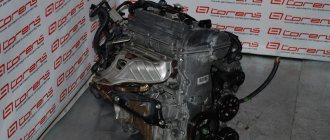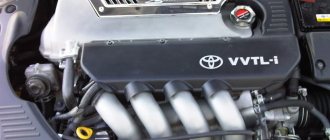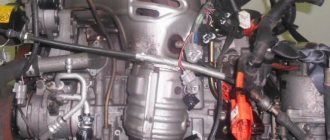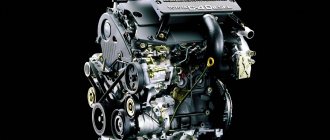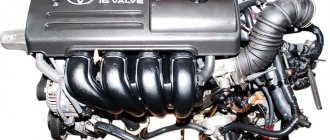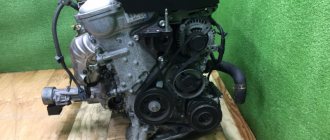Updated its expanded list of oils for Mitsubishi 4B1x, Hyundai/KIA Theta II (G4KD, G4KE) and Chrysler World Engine engines. Pros/cons in parentheses. IMHO.
Simpler and (sometimes) cheaper (pure ILSAC):
0W-20 Idemitsu Zepro (pros: record viscosity index, excellent low-temperature properties, very rich package of EP additives based on molybdenum and boron, high alkalinity, cons: price, poor availability)
5W-30 Idemitsu Zepro (pros: good package with molybdenum and boron, cons: low alkaline, poor availability)
5W-20/5W-30 Pennzoil Gold (Synthetic Blend) (pros: high alkaline, good low temperature, cons: no boron in the package, poor availability)
0W-20/5W-20/5W-30 Quaker State Ultimate Durability (pros: good low temperature, high alkaline, cons: no boron in package, poor availability, price)
5W-20/5W-30 Quaker State Enhanced Durability (pros: good package with molybdenum and boron, good low-temperature performance, cons: low alkalinity, poor availability)
0W-20/5W-20/0W-30/5W-30 Petro-Canada Supreme Synthetic (pros: good package with molybdenum and boron, good low-temperature performance, cons: low alkaline)
0W-20/5W-20/5W-30 Kendall GT-1 Full Synthetic (pros: good package with molybdenum, boron and titanium, good low-temperature performance, cons: poor availability)
5W-30 Kendall GT-1 Dexos1 (pros: good package with molybdenum and boron, good low-temperature performance, cons: low alkaline, poor availability)
0W-20 Total Future (pros: low price, low ash content, cons: low alkaline)
0W-20/5W-30 Motul Eco-Lite (API SN) (pros: low ash content, good package with molybdenum and boron, cons: low alkaline, mediocre low temperature)
5W-30 Liqui Moly Special AA (pros: low price, low ash content, cons: low alkaline)
0W-20/5W-20/5W-30 Eneos (pros: low price, low-ash package with molybdenum friction modifiers, relatively high alkalinity, cons: no boron in the package)
5W-20 Hyundai Premium LF Gasoline (pros: relatively low price, cons: no boron in the package)
0W-20/0W-30/5W-30 Mitsubishi Genuine (pros: relatively low price, wide availability, low-ash package with molybdenum friction modifiers, cons: very low alkaline, mediocre low-temperature performance, no boron in the package)
But in purely urban conditions, I would change these oils after 5-6 thousand km (4 thousand km in winter).
More powerful (ACEA A1 A5 and/or PAO oils (GTL) with esters):
0W-20/5W-20/5W-30 Pennzoil Ultra (Ultra Platinum) (pros: GTL base, high alkaline, excellent package with powerful ZDDP, molybdenum and boron, good low-temperature performance, cons: price, poor availability)
0W-20/5W-20/5W-30 Pennzoil Platinum (pros: base with GTL, high alkaline, good low-temperature performance, cons: price, poor availability, no boron in the package)
0W-20 Shell Helix Ultra (PurePlus) (pros: GTL base, high alkaline, good package with molybdenum and boron, good low-temperature performance, cons: poor availability)
0W-30 Shell Helix Ultra A5/B5 (PurePlus) (pros: GTL base, high alkaline, good package with molybdenum and boron, cons: poor availability)
0W-20/5W-20/0W-30/5W-30 Amsoil Signature Series (pros: PAO base with esters, very high alkaline, good package with molybdenum and boron, excellent low-temperature performance, cons: price, poor availability, high ash content )
0W-20/5W-20 Ravenol ECS/SFE (pros: PAO base, no viscosity modifier, high alkaline, excellent package with powerful ZDDP, molybdenum and boron, good low-temperature performance, relatively low price, cons: oils are still available in warehouses "old" recipe)
5W-30 Ravenol FO (pros: high alkaline, relatively low price, cons: mediocre low-temperature, relatively high ash content, package without molybdenum and boron)
0W-30 Valvoline SynPower FE (pros: base contains a little PAO, minimum viscosity modifier, very high alkalinity, excellent low-temperature performance, low price, cons: relatively high ash content, package without molybdenum and boron)
0W-20 Valvoline SynPower (pros: base contains some PAO, high alkaline, cons: mediocre low temperature, package without molybdenum and boron)
5W-30 Valvoline SynPower FE (pros: high alkaline, good low-temperature performance, low price, cons: package without molybdenum)
0W-30 Neste City Pro (pros: the base contains a little PAO, minimum viscosity modifier, high alkaline, excellent low-temperature properties, low price, cons: relatively high ash content, package without molybdenum and boron)
0W-20 Neste City Pro (pros: the base contains a little PAO, high alkaline, cons: mediocre low-temperature, package without molybdenum and boron)
5W-30 Neste City Standard (pros: high alkaline, good low-temperature performance, low price, cons: package without molybdenum)
5W-30 Mobil1 x1 (pros: high alkaline coupled with low ash content, good package with molybdenum and boron, good low-temperature performance, wide availability, cons: price in some places)
0W-20/0W-30 Mobil1 AFE (pros: base on a mixture of PAO and hydrocracking, excellent low-temperature performance, high alkalinity coupled with low ash content, good package with molybdenum and boron, cons: price)
0W-20/5W-20/5W-30 Mobil1 EP (pros: base on a mixture of PAO and hydrocracking, high alkalinity, good package with molybdenum and boron, good low-temperature performance, cons: price, poor availability)
0W-30 Mobil1 FE (pros: very high alkalinity, good package with molybdenum and boron, good low-temperature performance, wide availability, cons: price, high ash content)
0W-20 Fuchs Titan GT1 (pros: ester base, low ash content, high HTHS=2.95 (like 0W-30), cons: zinc-free additive package, price, poor availability)
0W-30 Toyota Genuine A5/B5 (pros: high alkaline, good low temperature, wide availability, cons: relatively high ash content, no boron in the package)
0W-30 Castrol Edge A5/B5 (pros: the base contains PAO, very high alkaline, excellent low-temperature, cons: price, relatively high ash content, package without molybdenum and boron)
5W-30 Castrol Edge A5/B5 (pros: very high alkaline, good package with molybdenum and boron, cons: price)
0W-20/5W-20/5W-30 Castrol Edge with Titanium (EP) (pros: good package with molybdenum, boron and titanium, high alkalinity, cons: price, poor availability)
5W-30 Aral High Tronic F (pros: high alkaline, good package with molybdenum and boron, cons: price in some places)
5W-30 Ford Formula F (pros: high alkaline, good package with molybdenum and boron, cons: price here and there)
0W-20 Motul Eco-Lite (API SM) (pros: PAO base with esters, high alkaline coupled with low ash content, excellent low-temperature performance, good package with molybdenum and boron, cons: price, poor availability, because recently discontinued from production, i.e. the recipe in API SN has changed radically)
0W-30 Motul Eco-Nergy (pros: very high alkaline, cons: price, relatively high ash content, package without molybdenum and boron)
5W-30 Motul Eco-Nergy (pros: high alkaline coupled with low ash content, cons: price, mediocre low-temperature performance, package without molybdenum)
0W-30 Total Quartz 9000 A5/B5 (pros: the base contains a little PAO, high alkaline, good low-temperature, cons: relatively high ash content, package without molybdenum and boron)
5W-30 Total Quartz 9000 Future NFC (pros: high alkaline, cons: no molybdenum package)
5W-30 Mazda Original (pros: high alkaline, cons: no molybdenum package)
5W-30 Hyundai-KIA (pros: high alkaline, cons: relatively high ash content, mediocre low-temperature performance, package without boron)
0W-20 NGN Future (pros: PAO base, high alkalinity, good low-temperature performance, cons: low viscosity index, relatively high ash content, package without friction modifiers)
5W-30 NGN Agate (pros: very high alkaline, good low-temperature performance, cons: relatively high ash content, package without molybdenum and boron)
5W-30 Lukoil Lux A5 (pros: low price, wide availability (still), high alkalinity, good low-temperature performance, cons: package without friction modifiers, discontinued)
5W-30 Lukoil Genesis Glidetech (pros: the database contains PAO, good low-temperature, relatively low price, wide availability, cons: boron-free package)
5W-30 Lukoil Genesis Armortech A5/B5 (pros: the base contains PAO, high alkaline, excellent low-temperature (almost 0W-30), relatively low price, cons: relatively high ash content, package without friction modifiers)
These oils are guaranteed to last 7.5 thousand km in the city (5-6 thousand in winter).
A little about the choice of viscosity: if the operation is only in the city, then it is quite possible to pour 0W-20 all year round. If mainly on the highway, then 5W-20/30 year-round. If in winter it’s only the city, and in summer it’s mostly on the highway, then 0W-20/5W-20(30) (winter/summer) or 0W-30 all year round. If there are very high speeds on the highway, then 5W-30 A5. If in the summer there are very heavy loads in the form of serious off-road or a heavy trailer, then it is better to pour high-quality synthetics 10W-30 (Pennzoil Ultra Platinum, Mobil1 EP, Castrol Edge EP, Amsoil SS).
5W-30 Valvoline Maxlife
5W-30/10W-30 Pennzoil High Mileage (winter/summer)
5W-30/10W-30 Mobil1 High Mileage (winter/summer)
At the same time, “jumping” to a higher viscosity 5W-40/50 does not make sense, IMHO.
Source
Description of the 2ZR-FE engine
2ZR-FE A classic representative of Toyota's inline fours. Production of the engine began in 2007, it was supposed to replace the disliked 1ZZ. The engine is built on the basis of an Aluminum block and an Aluminum cylinder head; the engine architecture can be called long-stroke - the piston stroke is 88.3 mm, and the liner diameter is 80.5 mm. Thanks to the light alloy, the engine weighs only 97 kilograms. Thanks to the long-stroke design, the engine is very economical and also has excellent traction from the lowest revs. The power unit has 2 phase shifters on each camshaft; the gas distribution mechanism is driven by a chain.
The cylinder head is built on the DOHC principle - it has two camshafts and 16 valves - 4 for each cylinder. Hydraulic compensators are used to adjust valve clearances; based on this, we can conclude that the engine will operate adequately only on high-quality oil.
Engine 2ZR-FE removed.
This power plant uses quite a lot of innovations, for example the Valvematic system, which allows you to adjust the valve lift height, and the Dual VVT-i system allows you to change the valve opening phases. A system for changing the length of the intake manifold has also been used. In the coupe, all this allowed us to achieve record low fuel consumption. And also get excellent power characteristics.
In the line of these power units, it is also worth noting the version operating on the Atkinson principle. The principle of this engine is that all strokes (injection, compression, power stroke, exhaust) occur in one revolution of the crankshaft. Power plants of this type have higher efficiency, but with all the advantages, they have very low torque and extremely poor throttle response. This power plant was labeled 2ZR-FXE and was installed on Toyota hybrid cars. It had only 98 horsepower and a huge compression ratio of 13 units.
A compressor was also installed on the 2ZR-FE from the factory, which made it possible to squeeze 212 horsepower out of the engine and remove as much as 250 HM of torque, without loss of service life.
Toyota 2ZR-FE/FAE/FXE engine tuning
Turbine for 2ZR-FE/FAE/FXE
There are 2ZR turbo kits on the market for quite reasonable money, based on a 28 Garrett, with a full set: turbine, intercooler, manifold, all piping, blowoff, 440/500cc injectors, cold air intake, all filters, pump walbro 255. All you have to do is buy it, install it, add an exhaust on a 2.5″ pipe and configure it, for example, with Greddy E-manage. Similar configurations give 250-300 hp. But in order for the engine to run without problems, you need to change the ShPG to a forged one with a compression ratio of 8.5-9 or blow into a standard piston no more than 0.5 bar. Similar things can be implemented on 1ZR/3ZR engines. For those concerned about resources, this procedure is strictly contraindicated.
ENGINE RATING: 4
<<BACK
Maintenance schedule 2ZR-FE
The power plant is quite capricious. To maintain and extend the declared resource of 200,000 kilometers, the power plant must be systematically maintained. Timely replacement of consumables and moderate loads will not only preserve the resource of the unit, but also increase it.
One of the most important consumables is engine oil; the engine is very capricious in terms of lubricant quality, as it is equipped with a Dual VVT-i system and hydraulic compensators; incorrectly selected or low-quality oil can cause problems with phase shifters and hydraulic pushers, and untimely replacement can cause VVT-i valves to stick .
To avoid unpleasant consequences, you should only fill in the oil recommended by the manual - Toyota brand, viscosity 5W-30.
- The timing chain should be checked every 40 thousand kilometers, and it needs to be replaced after 100,000 kilometers; all tensioners and rollers are also changed along with the chain; if this is not done, the chain will begin to rattle after long runs or even jump, jumping the chain threatens the valves meeting and pistons, since the power plant bends the valve;
- The spark plugs need to be monitored once every 20 thousand km. During checks, it is worth cleaning them and adjusting the gap, spark plugs are changed once every 60 thousand kilometers, neglecting this rule can bring disastrous consequences - the ignition coils can fail;
- The oil should be changed every 10 thousand km; if this is not done, then deposits may occur in the VVT-i valves, and the hydraulic compensators will fail quite quickly;
- The condition of drive belts of attachments should be checked every 50 thousand km and replaced if necessary;
- It is recommended to change the coolant every 4 years of vehicle operation; the condition of the pump should be checked every 50 thousand kilometers.
Best oil
What viscosity should I choose?! To answer this question, there are several important points to consider:
- area of use;
- seasonality (summer/winter);
- engine condition and vehicle mileage;
City
It is considered the most loaded for the engine, because there are constant stops, short distances, traffic lights, traffic jams and the like on the way.
The best and least loaded country mode
(highway): with stable speed and constant speed.
It is also necessary to take into account the climate
. So, say, for a Toyota RAV4 XA40 engine that is operated in the summer or in hot climates, the ideal choice would be 5W-20, 5W-30 and in some cases 5W-40, while in cold weather you need to fill in less thick engine oil - 0W-20 or 0W-30. As a result, an engine with optimally selected oil is quieter, starts better in cold weather, and even reduces fuel consumption.
The third factor is the condition of the engine
. After 100-150 thousand km, engine parts wear out and it is recommended to “switch” to a thicker engine oil, for example from 0W-20 to 0W-30 or from 5W-20 to 5W-30, etc., but again, this It's an individual question.
5W-20
- Quaker State Ultimate Durability 5W-20
- Mobil 1 5W-20 Advanced Full Synthetic
- Petro-Canada Supreme Synthetic 5W-20
- RAVENOL SFE 5W-20
- Redline 5W-20 Motor Oil
- United EcoElite 5W-20
- Wolf Vitaltech 5W-20 D1 Dexos1 Gen2
0W-20
- Amsoil Signature Series 100% Synthetic 0W-20
- Eurol Evolence 0W-20
- Fuchs Titan Syn 0W-20
- Idemitsu Zepro 0W-20
- Kendall GT-1 Full Synthetic with Liquid Titanium 0W-20
- Kixx G1 0W-20
- Lukoil Genesis Special FE 0W-20
- MAG1 Dexos1 0W-20
- Mobil Advanced Fuel Economy 0W-20
- Neste City Pro 0W-20
- NGN Future 0W-20
- Petro-Canada Supreme Synthetic 0W-20
- Profix 0W-20
- RAVENOL ECS 0W-20
- S-Oil Seven Red1 0W-20
- Shell Helix Ultra 0W-20
- TCL Zero Line 0W-20
- Toyota Motor Oil 0W-20 (08880-12205)
- United Eco Elite 0W-20
- Wolf Ecotech 0W-20 D1 FE
5W-30
- Addinol MV 0537 5W-30
- Amsoil Signature Series 5W-30
- Blend Liquid Titanium 5W-30
- Gtoil Energy 5W-30
- Hyundai Xteer Ultra GSL 5W-30
- Idemitsu Zepro Touring 5W-30
- Lukoil Genesis Glidetech 5W-30
- Mobil 1 ESP Formula 5W-30
- Mobil1 X1 5W-30
- Petro-Canada Supreme Synthetic 5W-30
- Pennzoil Platinum 5W-30
- Pennzoil Ultra Platinum Full Synthetic 5W-30
- Profix 5W-30
- SSU GXO 5W-30
- Wolf Vitaltech 5W-30 ASIA-US
- United Eco Elite 5W-30
- ZIC A 5W-30
0W-30
- Addinol Superior 0W-30
- Castrol Edge 0W-30
- Toyota Engine Oil Synthetic 0W-30
- Mobil 1 Fuel Economy 0W-30
- Petro-Canada Supreme Synthetic 0W-30
- Ravenol SSO 0W-30
- Shell 0W-30 A5/B5
Review of 2ZR-FE faults
- Binge on oil after a run of 100 thousand kilometers. Most often, the problem lies in the oil seals; replacing them helps eliminate oil consumption in 70% of cases; if this does not help, then perhaps you should change the viscosity and oil manufacturer. In the worst case scenario, a major overhaul of the CPG will be required;
- Engine knocking often appears due to a stretched timing chain or failed hydraulic compensators; if the hydraulic compensators can be repaired by washing, then the timing chain only needs to be replaced; the knocking can also occur due to a worn crankshaft damper pulley. Even if the cylinders are elliptical, the pistons may produce an unpleasant knocking sound during repositioning; this is also accompanied by high oil and fuel consumption; in this case, only a major overhaul of the power plant will help;
- Problems with XX speed are most often caused by clogged injectors or throttle assembly; flushing the fuel system and IAC valve will help cure the problem 100%. Often, unstable idling is caused by jammed valves of the VVT-I system, which is also accompanied by engine dullness and high fuel consumption;
- Since the engine block is made of aluminum, overheating, even the slightest, is very dangerous for it, any excess of the coolant temperature can lead to a change in the geometry of the mating planes of the block and cylinder head, and the power plant thermostat also adds fuel to the fire, which often fails and interferes with the cooling system work, if you have problems with the thermostat, then operating the power plant is highly not recommended.
In general, the 2ZR-FE engine turned out to be quite reliable and with proper handling, systematic maintenance and moderate loads, it will live a long life and fully work out the resource declared by the manufacturer.
What to fill
Perhaps this is the most important section for every owner of a modern car. Most of us, when buying the same engine oil for a Toyota Corolla 150, are guided in our choice by advice and working advertising, and this is wrong.
It is necessary to fill only with synthetic original oil from the manufacturer. It does not have to be Toyota oil, but it must be original oil and not a fake. If you are not sure that the oil in front of you is from the exact manufacturer indicated on the label, do not buy it, the consequences will entail expensive repairs.
Also, the oil must meet the requirements, tolerances and class recommended by the manufacturer
Before purchasing, you should consider not the sensational name of the oil, but your individual needs. Needs mean specific operating conditions:
Urban mode is considered the most extreme, since there are constant stops, traffic lights, traffic jams, short distances, etc. along the way.
The track provides the engine with the best conditions - one speed mode, optimal speed and pressure in the oil system, and the air-fuel mixture cools and burns properly.
It is also important to take into account the technical condition of the engine, oil consumption per 1000 km and total mileage. Since this subsequently affects the choice of oil viscosity. The oil quality group is also important - SJ, SL or SM
Only the car owner himself can tell you what oil to fill, knowing his car and operating conditions.
For a new car, 0W20 and 0W30 oil is recommended, with its further replacement with 5W30 and 5W40.
Below is a list of the most popular brands of motor oils among Toyota Corolla E150 owners. It will be relevant especially for those who recently bought a car and this is the first replacement, as well as for those who are disappointed in their motor oil. Keep in mind, this is just the choice of other owners of the Toyota Corolla 150, and if you change the oil yourself, in the future you need to analyze the effect of the oil on the engine, its consumption, as well as possible leaks.
The list is sorted in descending order, from the most popular to the least popular:
Winter period
Tuning options
Atmospheric tuning of the power plant will not give much effect, because the engineers have squeezed almost all its potential out of the engine. But you can still install worse camshafts, port the cylinder head and increase the compression ratio, install a direct-flow exhaust system, and also adjust the electronic control unit. All this will give an increase of 10-20 horsepower, these upgrades are not worth the money spent, the easiest way is to do a swap and install the 2ZR-FE compressor version.
List of car models in which it was installed
- Toyota Allion - (06.2007 - 03.2010) - sedan, 2nd generation, T260
- Toyota Auris (10.2006 - 09.2009) hatchback, 1st generation, E150
- Toyota Corolla (03.2016 - present) restyling, sedan, 11th generation, E180
- Toyota Corolla (05.2012 - 07.2016) sedan, 11th generation, E180
- Toyota Corolla (04.2013 - present) sedan, 11th generation, E170
- Toyota Corolla (10.2010 - 09.2013) restyling, sedan, 10th generation, E140
- Toyota Corolla (01.2008 - 09.2010) sedan, 10th generation, E140
- Toyota Corolla Axio (10.2008 - 04.2012) restyling, sedan, 1st generation, E140
- Toyota Corolla Axio (10.2006 - 09.2008) sedan, 1st generation, E140
- Toyota Corolla Fielder (10.2008 - 04.2012) restyling, station wagon, 2nd generation, E140
- Toyota Corolla Fielder (10.2006 - 09.2008) station wagon, 2nd generation, E140
- Toyota Corolla Rumion (10.2007 - 11.2009) hatchback, 1st generation, E150
- Toyota ist (07.2007 - 04.2016) hatchback, 2nd generation, XP110
- Toyota Matrix (02.2008 - 08.2013) hatchback, 2nd generation, E140
- Toyota Premio (06.2007 - 03.2010) sedan, 2nd generation, T260
- Toyota Vitz (01.2017 - present) 2nd restyling, hatchback, 3rd generation
How much oil to fill
The table below provides a list of Toyota engines in the E150 body, and a recommendation - how much oil should be filled during a complete change. The Toyota Corolla engine requires from 3.7 to 5.0 liters of engine oil, but the exact figure depends on the specific engine.
Gasoline engines
For gasoline engines, oils with oil classification API SL..SM are recommended.
| Model/Volume | Oil capacity, filter capacity, liters | ||
| NRE15 | 1NR-FE | 1.3i/1.33 | 3.4/0.2 |
| ZZE15 | 4ZZ-FE | 1.4 VVT-i/1.4 | 3.7/0.2 (2007-’08) 4.2/0.2 (2008-’09) |
| ZRE15 | 1ZR-FE/FAE | 1.6 Dual VVTi/1.6 | 4.2/0.3 |
| ZRE142 (USA/Canada) | 2ZR-FE | 1.8 VVT-i/1.8 | 4.2/0.3 |
| AZE141 (USA/Canada) | 2AZ-FE | 2.4 16V/2.4 | 3.8/0.2 |
Diesel engines
For diesel engines, oils with API classification CF..CF-4 / ACEA B1 are recommended. C2
| Body number | Engine | Model/Volume | Oil capacity, filter capacity, liters |
| NDE15 | 1ND-TV | 1.4 D-4D/1.4 | 4.3/0.5 (2007-’09) 4.1/0.5 (2009-’11) 3.9/0.4 (2011-’13) |
| ADE15 | 1AD-FTV | 2.0 D-4D/2.0 | 6.3/0.4 |
It is worth noting that these recommendations are relevant not only for the Corolla E150 / E140, but also for other Toyota models equipped at a certain period with the engines indicated above and produced not only for Russia, but also for Europe, the USA and Japan. therefore, the year of manufacture may not correspond to models for the CIS countries:
| Model | Engine & Volume | Year of issue |
| Alphard H10, H20 | 2AZ 2.4 | 2002-2015 |
| Allion T260 | 2ZR 1.8 | 2007-2010 |
| Auris E150 | 1NR 1.3/4ZZ 1.4/1ZR 1.6/2ZR 1.8, 1ND 1.4/1AD 2.0 | 2006-2012 |
| Auris E180 | 1NR 1.3/1ZR 1.6, 1ND 1.4/1AD 2.0 | 2012-2016 |
| Avensis T270 | 1AD 2.0 | 2008-2015 |
| Blade E150 | 2AZ 2.4 | 2006-2012 |
| Camry XV40, XV30 | 2AZ 2.4 | 2001-2011 |
| Corolla E110 | 4ZZ 1.4 | 1999-2001 |
| Corolla E120 | 4ZZ 1.4/1ND 1.4 | 2000-2007 |
| Corolla E170 | 2ZR 1.8 | 2013-2018 |
| Corolla E180 | 1NR 1.3/1ZR 1.6/2ZR 1.8/1ND 1.4 | 2012-2019 |
| Corolla E210 | 1ZR 1.6 | since 2018 |
| Corolla Axio E140 | 2ZR 1.8 | 2006-2012 |
| Corolla Axio E160 | 1NR 1.3 | since 2012 |
| Corolla Fielder E140 | 2ZR 1.8 | 2006-2012 |
| Corolla Rumion | 2ZR 1.8 | 2007-2009 |
| Estima AHR10, AHR20, XR30, XR40, XR50 | 2AZ 2.4 | 2000-2019 |
| iQ GJ10 | 1NR 1.3 | 2008-2011 |
| Ipsum ACM20 | 2AZ 2.4 | 2001-2009 |
| ist XP110 | 2ZR 1.8 | 2007-2016 |
| Kluger V XU20 | 2AZ 2.4 | 2000-2007 |
| Harrier XU10, XU30 | 2AZ 2.4 | 2000-2013 |
| Highlander XU20 | 2AZ 2.4 | 2000-2007 |
| Mark X Zio NA10 | 2AZ 2.4 | 2007-2013 |
| Matrix E140 | 2ZR 1.8/2AZ 2.4 | 2008-2013 |
| Passo XC30 | 1NR 1.3 | 2010-2016 |
| Porte NP140 | 1NR 1.3 | since 2012 |
| Premium T260 | 2ZR 1.8 | 2007-2010 |
| Probox XP50, XP160 | 1NR 1.3/1ND 1.4 | since 2014 |
| Ractis P120 | 1NR 1.3 | since 2010 |
| RAV4 CA20W | 2AZ 2.4 | 2003-2005 |
| RAV4 XA30 | 2AZ 2.4 | 2005-2016 |
| RAV4 XA40 | 1AD 2.0 | 2012-2015 |
| Solara XV20, XV30 | 2AZ 2.4 | 2001-2009 |
| Spade NP140 | 1NR 1.3 | since 2012 |
| Succeed XP60, XP160 | 1ND 1.4 | 2002-2014 |
| Vanguard XA30 | 2AZ 2.4 | 2007-2013 |
| Vellfire H20 | 2AZ 2.4 | 2008-2015 |
| Vitz XP130 | 1NR 1.3/2ZR 1.8 | 2010-2020 |
| Yaris XP10 | 1ND 1.4 | 1999-2005 |
| Yaris XP 90 | 1NR 1.3/2ZR 1.8/1ND 1.4 | 2005-2010 |
| Yaris XP 130 | 1NR 1.3/1ND 1.4 | 2010-2014 |
Specifications
ATTENTION! A completely simple way to reduce fuel consumption has been found! Don't believe me? An auto mechanic with 15 years of experience also didn’t believe it until he tried it. And now he saves 35,000 rubles a year on gasoline! Read more"
The 2ZR-FAE engine, like all other units in this line, is a 4-cylinder in-line engine with a DOCH gas distribution system, with 16 valves, four for each cylinder.
The entire series of ZR engines is divided into 3 types of units with 1.6; 1.8 and 2.0 liter volume. For the first time in the history of Toyota, the Valvematic system was installed on them. The proprietary double VVT-i gas distribution system and Valvematic were also installed on the 2ZR-FAE engine, which, depending on the quality and operating conditions of the engine, can dynamically change valve lift from 1 to 11 mm, with an increased compression ratio to 10.5:1 .
The 2ZR-FAE engine is ten percent more economical, low consumption occurs at cruising speed, and directly depends on the air temperature at the time of the trip. Its power ranges from 143–150 hp, at a speed of 6600 rpm. and 173–180 H•m, at 4400 rpm. in a minute. The power developed by the car directly depends on the different settings of the engine control unit (ECU) included in the package.
| Volume | 1.8 l. (1797 cm3) |
| Power | 139–148 hp |
| Torque | 171–175 N*m |
| Compression ratio | 10.5:1 |
| Cutoff | 6600 rpm |
Components, elements and characteristics of 2ZR-FAE;
- Cast engine block;
- Light-alloy, lined aluminum alloy cylinder block;
- Eight-millimeter desaxing of the crankshaft;
- Light alloy T-shaped pistons connected to connecting rods with floating pins;
- One-piece cast crankcase, with the possibility of dismantling without completely disassembling all structural elements;
- Vertical arrangement of the engine, which is mounted on 4 supports;
- All engines have the same cylinder diameters and distinguishable piston strokes;
- Hydraulic compensators installed;
- The timing drive is a single-row chain.
Toyota 2ZR engine characteristics
| Production | Toyota Motor Manufacturing West Virginia Shimoyama Plant |
| Engine make | Toyota 2ZR |
| Years of manufacture | 2007-present day |
| Cylinder block material | aluminum |
| Supply system | injector |
| Type | in-line |
| Number of cylinders | 4 |
| Valves per cylinder | 4 |
| Piston stroke, mm | 88.3 |
| Cylinder diameter, mm | 80.5 |
| Compression ratio | 10 10.5 13 |
| Engine capacity, cc | 1797 |
| Engine power, hp/rpm | 128/6000 132/6000 136/5200 136/6000 140/6000 144/6400 147/6400 |
| Torque, Nm/rpm | 171/4400 207/4000 172/4400 175/4400 174/4400 176/4400 180/4000 |
| Fuel | 95 |
| Environmental standards | Euro 5 |
| Engine weight, kg | 97 (dry) |
| Fuel consumption, l/100 km (for Corolla E170) - city - highway - mixed. | 8.3 5.3 6.4 |
| Oil consumption, g/1000 km | up to 1000 |
| Engine oil | 0W-20 5W-20 5W-30 10W-30 |
| How much oil is in the engine | 4.2 |
| Oil change carried out, km | 10000 (better 5000) |
| Engine operating temperature, degrees. | — |
| Engine life, thousand km - according to the plant - in practice | n.d. ~250 |
| Tuning - potential - without loss of resource | 250+ n.a. |
| The engine was installed | Toyota Avensis Toyota CorollaToyota Matrix Toyota Premio Toyota Yaris Toyota Corolla Rumion Toyota iSt Toyota Wish Toyota Prius Toyota Auris Toyota Verso Lexus CT200h Scion xD Pontiac Vibe Lotus Elise |
Features of operation and main defects
If you structure the reviews of owners of cars with an installed engine, you can count quite a few defects.
- Oil consumption – increased;
- Combustion chamber – deposition of combustion products;
- VVT drive - knocking sound when starting;
- Pump leakage;
- Vacuum pump – excessive noise when the motor is running;
- Oil is leaking from under the chain cover;
- Forced idle errors;
- Low fuel pressure - as a result, hot starting problems.
It is difficult to calculate the approximate service life of an engine with an accuracy of one year. An installed chain with an advertising slogan - “work throughout the entire service life of the car” does not always live up to reality. It’s not harmful to dream, but it obviously won’t last several hundred thousand km.
Although it is worth noting that the service life of a chain, compared to a belt, is indeed slightly longer, due to the fact that it rarely breaks and does not require scheduled replacement every six months. The only thing that is true is that it, like the belt, needs to be carefully monitored; if the chain breaks, a meeting with the valves is inevitable, and this is a repair that costs a tidy sum.
In principle, it does not require any special intervention, but the chain travel limit is about 150 thousand km. Then it begins to stretch, the hydraulic tensioner loses its position, the chain begins to literally “saw through” the tensioners and dampers, wearing out the shaft rollers, and wear products get into the engine oil. The service life of the engine itself is noticeably reduced.
Owners' choice
The range of oils is quite wide, but it is worth mentioning several oils that are most popular among RAV4 XA40 owners. Which one to choose is up to you, since you need to take into account the budget for maintenance, availability of oils, credibility of the seller, etc.
Considering that there are often counterfeits of popular oils on the market, we recommend that you first contact the official representative of the oil manufacturer you have chosen (of course, if there is one). If you choose original Toyota oil, before purchasing, please read the nuances that distinguish the original from a fake: in plastic and in a reinforced concrete canister.
2.0 3ZR
Owners of ZSA42 and ZSA44 (years of manufacture: 2012, 2013, 2014, 2015, 2016, 2021, 2018) prefer to pour oils from trusted global brands.
Summer (5W-30)
- Idemitsu ZEPRO Touring 5W-30
- Mobil 1 x1 5W-30
- MOTUL 8100 X-clean EFE SAE 5W-30
- Ravenol FDS 5W-30
- PROFIX 5W-30
- SRS oil ViVA 1 topsynth alpha LA 5W-30
- Suprotec Atomium 5W-30
- Total Quartz 5W-30
Winter (0W-20 & 0W-30)
- Amsoil Signature Series 0W-20
- Idemitsu ZEPRO Eco Medalist 0W-20
- MOTUL 8100 Eco-lite 0W-20
- Ravenol ECS 0W-20
- ZIC ZERO 20 0W-20
- Idemitsu ZEPRO Touring Pro 0W-30 (3615004)
- Total Quartz Ineo First 0W-30
- Toyota 0W-30 (08880-80360-GO, 208 l barrel for bottling)
2.2 2AD
Owners of Rafiks with an ALA49 diesel engine (years of manufacture: 2012, 2013, 2014, 2015, 2021, 2021, 2018), as recommended by the manufacturer, use thicker oils.
Summer (5W-30 & 5W-40)
- Armortech Diesel 5W-30
- Chevron DELO® 400 LE 5W-30
- Liqui Moly Top Tec 4200 Diesel 5W-30
- Mobil1 FS 5W-30
- Motul Eco Energy 5W-30
- Shell Helix Ultra 5W-40
- Total Rubia TIR 9900 FE 5W-30
- Toyota 5W-30 PFE (08880-82720-GO)
- Motul 5W-40 X-clean
- Lukoil Avangard Ultra CI-4/SL 5W-40
Winter (0W-30)
- Castrol EDGE Turbo Diesel 0W-30
- Motul X-clean+ 0W-30
- RAVENOL VSW 0W-30
- RAVENOL SSO 0W-30
- Shell Helix Ultra ECT C2/C3 0W-30
- Shell Helix Ultra Professional AV-L 0W-30
- Toyota Engine Oil 0W-30 (08880-80365-GO)
- Toyota 0W-30 PFE (08880-82872)
2.5 2AR
In RAV4 ASA44, AVA42/AVA44 (manufacturing years: 2015, 2021, 2021, 2018), owners of crossovers with a 2.5-liter engine of the 2AR family prefer to use almost the same as owners with a 2.0-liter engine.
Summer (5W-30)
- Amsoil SS 5W-30
- Idemitsu ZEPRO Touring 5W-30
- Mobil 1 ESP 5W-30
- Mobil Super 3000 XE 5W-30
- Tatneft Lux 5W-30
Winter (0W-20 & 0W-30)
- Idemitsu ZEPRO Eco Medalist 0W-20
- Mobil 1 Advanced Full Synthetic 0W-20
- Toyota SAE 0W-20 0.946l 00279-0WQTE-6S
- Idemitsu ZEPRO Touring Pro 0W-30 (3615-004)
- RAVENOL SSV 0W-30
Vehicles with 2ZR-FAE engine
The team of cars equipped with the 2ZR-FAE engine is Toyota;
- Auris;
- Avensis;
- Corolla Rumion;
- IST;
- Wish;
- Verso;
- The latest models, from 2010 to the present - Allion and Premio.
Instead of an epilogue, we can say that the absence of major breakdowns throughout the entire warranty period of the engine, optimal winter starting and reasonable fuel consumption is already an achievement. And conclusions about whether the engine is good or bad can be made quite confidently after several years of operation.


